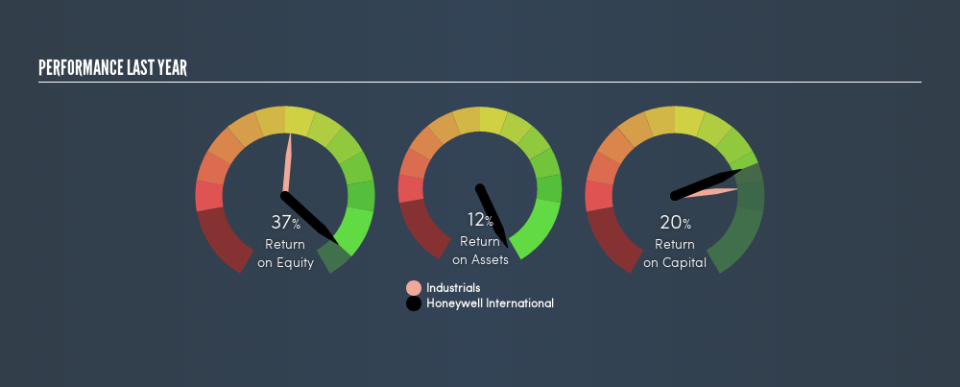How Good Is Honeywell International Inc. (NYSE:HON) At Creating Shareholder Value?

Today we are going to look at Honeywell International Inc. (NYSE:HON) to see whether it might be an attractive investment prospect. Specifically, we’ll consider its Return On Capital Employed (ROCE), since that will give us an insight into how efficiently the business can generate profits from the capital it requires.
First, we’ll go over how we calculate ROCE. Then we’ll compare its ROCE to similar companies. Last but not least, we’ll look at what impact its current liabilities have on its ROCE.
What is Return On Capital Employed (ROCE)?
ROCE measures the amount of pre-tax profits a company can generate from the capital employed in its business. Generally speaking a higher ROCE is better. Overall, it is a valuable metric that has its flaws. Author Edwin Whiting says to be careful when comparing the ROCE of different businesses, since ‘No two businesses are exactly alike.’
So, How Do We Calculate ROCE?
The formula for calculating the return on capital employed is:
Return on Capital Employed = Earnings Before Interest and Tax (EBIT) ÷ (Total Assets – Current Liabilities)
Or for Honeywell International:
0.20 = US$7.8b ÷ (US$58b – US$19b) (Based on the trailing twelve months to December 2018.)
So, Honeywell International has an ROCE of 20%.
View our latest analysis for Honeywell International
Want to participate in a research study? Help shape the future of investing tools and earn a $60 gift card!
Does Honeywell International Have A Good ROCE?
ROCE can be useful when making comparisons, such as between similar companies. Using our data, Honeywell International’s ROCE appears to be around the 17% average of the Industrials industry. Regardless of where Honeywell International sits next to its industry, its ROCE in absolute terms appears satisfactory, and this company could be worth a closer look.
When considering this metric, keep in mind that it is backwards looking, and not necessarily predictive. Companies in cyclical industries can be difficult to understand using ROCE, as returns typically look high during boom times, and low during busts. ROCE is, after all, simply a snap shot of a single year. Future performance is what matters, and you can see analyst predictions in our free report on analyst forecasts for the company.
Do Honeywell International’s Current Liabilities Skew Its ROCE?
Short term (or current) liabilities, are things like supplier invoices, overdrafts, or tax bills that need to be paid within 12 months. Due to the way ROCE is calculated, a high level of current liabilities makes a company look as though it has less capital employed, and thus can (sometimes unfairly) boost the ROCE. To check the impact of this, we calculate if a company has high current liabilities relative to its total assets.
Honeywell International has total liabilities of US$19b and total assets of US$58b. Therefore its current liabilities are equivalent to approximately 33% of its total assets. Honeywell International has a medium level of current liabilities, which would boost the ROCE.
What We Can Learn From Honeywell International’s ROCE
Honeywell International’s ROCE does look good, but the level of current liabilities also contribute to that. Of course you might be able to find a better stock than Honeywell International. So you may wish to see this free collection of other companies that have grown earnings strongly.
If you are like me, then you will not want to miss this free list of growing companies that insiders are buying.
We aim to bring you long-term focused research analysis driven by fundamental data. Note that our analysis may not factor in the latest price-sensitive company announcements or qualitative material.
If you spot an error that warrants correction, please contact the editor at editorial-team@simplywallst.com. This article by Simply Wall St is general in nature. It does not constitute a recommendation to buy or sell any stock, and does not take account of your objectives, or your financial situation. Simply Wall St has no position in the stocks mentioned. Thank you for reading.


